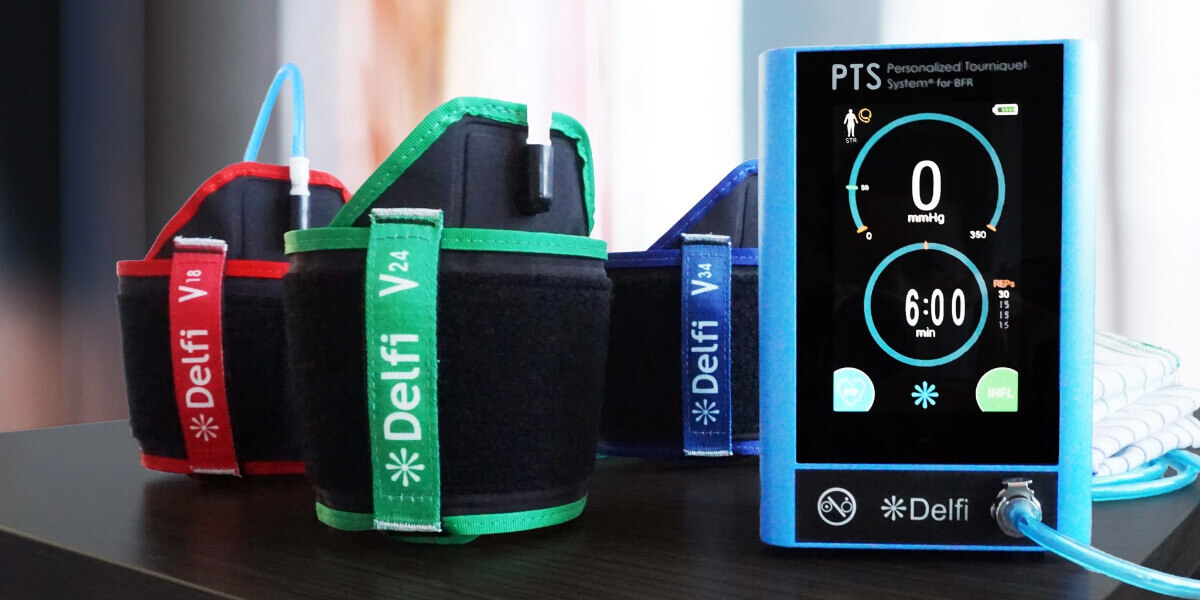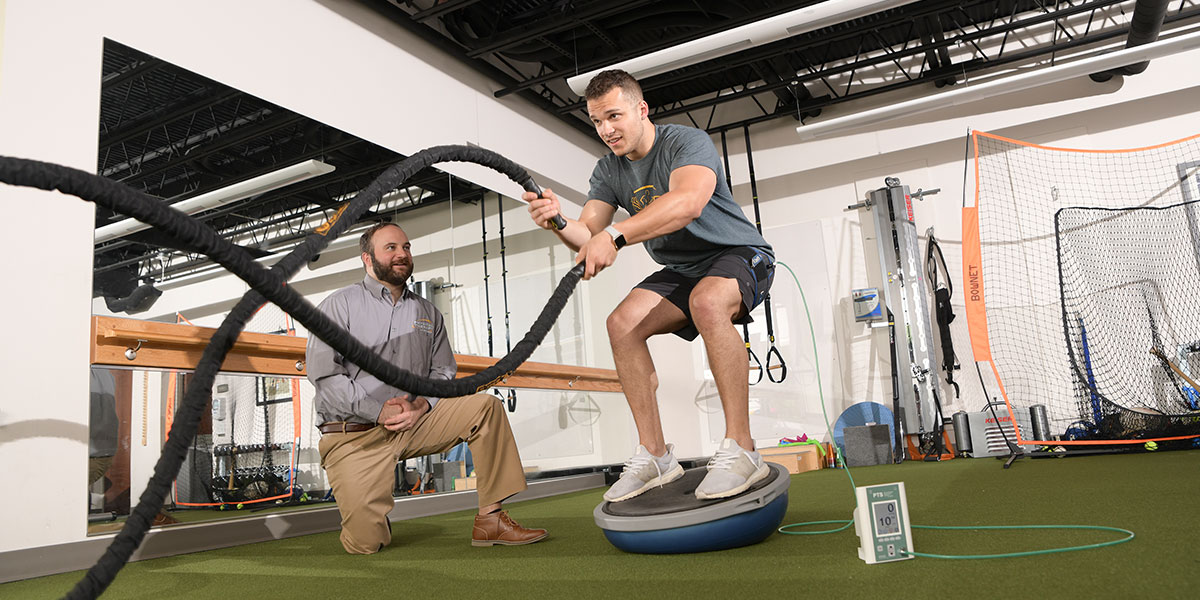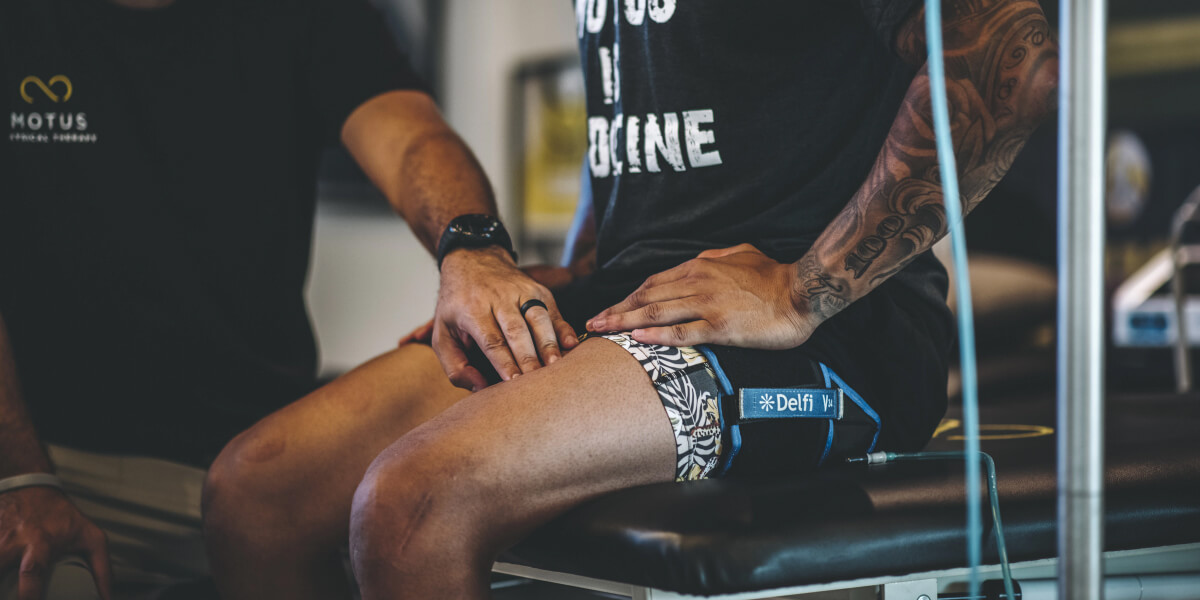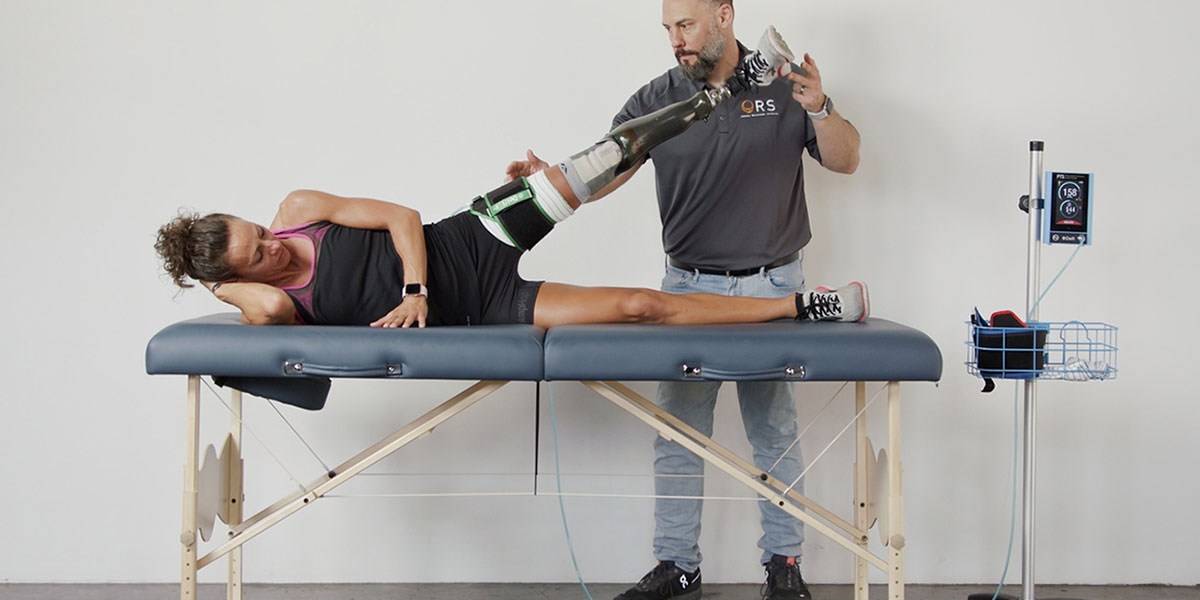Blood Flow Restriction Training in Physical Therapy: Considerations of Methodology, Application,
and Safety
The upcoming blog outlines guidelines regarding blood flow restriction (BFR) training with a focus on methodology, application, and safety in a rehabilitation setting. The purpose of this blog is to present an updated and research-informed guide for utilizing and managing BFR training in patients. As it relates to the use of limiting blood flow, using the Owens Recovery Science’s personalized tourniquet system, for increasing muscular strength and limiting muscle atrophy with aerobic and resistance exercises.

Tell me about blood flow restriction (BFR) training?
The first consideration is the type of equipment that is used for blood flow restriction. There are a few different options available, but the most popular clinical device is the Owens Recovery Science's personalized tourniquet system made by Delfi. This blood pressure cuff is placed around the proximal aspect of the limb (upper arm or top of the leg) being used and inflated to restrict blood flow.
The second consideration is the method of cuff pressure which is specific to each individual. The Delfi BFR device is specifically designed to safely regulate and control tourniquet pressure for blood flow restriction applications and includes advanced personalization and safety features. Limb occlusion pressure is the only way to individualize the application for each patient and limb. The built-in, patented limb occlusion technology removes human error from the equation as the device determines the amount of pressure needed to fully occlude the limb. Safe exercise parameters are set by clinical research studies and are programmed into the device. These safety features include auto-inflation, adjustable pressure limiting, and a built-in pressure gauge to ensure that cuff pressure is always within the recommended safe range. The pressure is limited to 50% of total limb occlusion pressure for upper body exercises, whereas the lower extremity parameters are set at 80% of total limb occlusion pressure.
The third consideration is the intensity and duration of the training sessions. The intensity of the exercises should be gradually increased over time in order to allow the muscles to adapt. The primary advantage to blood flow restriction is that you can increase muscle size at a very low intensity. Exercise selection will vary based on patient tolerance and your physical therapist's discretion based on the goal of your rehabilitation. The typical duration of a BFR session is 10-20 minutes, but this can vary depending on the intensity and goals of the training program.

Blood flow restriction training: adaptive
responses and potential mechanisms
The use of blood pressure restrictions has been shown to improve muscular hypertrophy (muscle size) as well as strength and elasticity. Basically, your arterial blood flow (oxygen-rich blood) continues to your muscles during blood flow restriction training — but your venous blood flow (oxygen-depleted blood) is restricted. In other words, blow flow restriction is about preventing blood from leaving the muscle rather than preventing blood from getting to the muscle.
Simply stated, muscular adaptation happens via neural, biomechanical, and metabolic processes. Many of these mechanisms involve very complex, multi-step pathways, but what the resisted blood flow allows the blood to pool in the muscle during light intensity strengthening.
The same metabolic stress and processes that occur with heavy high load resistance exercise happen with a much lighter load, leading to muscle hypertrophy. This occurs by increasing the blood flow and metabolic stress within the muscle, which then activates satellite cells.
Satellite cells are precursor cells that fuse with the muscle fibers, leading to an increase in myonuclei number. Myonuclei are important for protein synthesis (building muscle) and hypertrophy.

Muscle hypertrophy with low load resistance exercise
Muscle weakness may be caused by several different ailments, injuries, or pathological conditions. Increasing weight resistance training is the most effective method of increasing strength and gaining muscle hypertrophy. In certain populations requiring muscle enhancing e.g. chronic pain patients or post-operative patients, heavyweight and intensity exercises are not clinically appropriate or tolerated by the patient.
Traditional muscle hypertrophy requires intense training with loads that exceed 75% of 1-repetition maximum or low load resistance exercise (40-500%RM) for a sustained duration. However, with BFR training there’s growing evidence that resistance training (20-40%) can also cause muscular augmentations.
Blood flow restriction studies show changes in muscle cells physiology to stimulate skeletal muscle hypertrophy. Blood flow restriction studies show changes in muscle cells physiology to stimulate skeletal muscle hypertrophy. The research has shown that metabolic stress is incredibly efficient when combined with the mechanical stress causing hypertrophic changes.

Cardiovascular protocol
Yes, BFR can be used for improving VO2max when aerobic protocols apply! Blood flow restriction has been proven to be an effective aerobic training protocol that increases VO2max without causing any damage to the muscles or tissues. Low-intensity occlusion aerobic exercise, such as walking and cycling, improves cardio endurance and muscular strength.

Contraindications
Below is a list of some of the many contraindications:
-Circulatory issues or clot risk (DVT)
-Heart disease/insufficiency
-Severe, uncontrolled hypertension
-Diabetes
-Varicose Veins
-Pregnancy
-Infection
-Cancer
-Lymphedema

Healthy & athletic populations
Due to the low load required using blood pressure restrictions and limited muscle damage that occurs, athletes can enjoy reduced training load but also gain physiological stimulation to improve muscular adaptation in their bodies. Athletes seeking to increase longevity could benefit from decreasing mechanical stresses through blood flow restriction training. During blood flow restriction exercise both muscle strength and muscle hypertrophy occurs with less muscle damage.
Overall, blood flow restriction training appears to be a promising tool for rehabilitating injuries and improving strength and muscle mass. However, more research is needed to determine the long-term benefits and safety of BFR. Prior to starting a blood flow restriction program, it is important to consult with a physical therapist to ensure that it is safe and appropriate for your individual needs.
References
- Mizuno, T., Nosaka, K., Isobe, T., Kobayashi, H., & Sato, J. (2006). Effects of blood flow restriction on muscle damage and muscle function. Medicine and Science in Sports and Exercise, 38(8), 1477-1485.
- Takarada, Y., Nakamura, Y., Aruga, S., Onda, T., Miyazaki, M., & Ishii, N. (2000). Rapid increase in plasma growth hormone after low-intensity resistance exercise with vascular occlusion. Journal of Applied Physiology, 88(6), 2097-2106.
- Loenneke, J. P., Wilson, J. M., Marin, P. J., Bemben, M. G., & Phillips, S. M. (2012). Low-load blood flow restriction training stimulates muscle protein synthesis more than high-load resistance training in young men during early phase recovery. Journal of Strength and Conditioning Research, 26(10), 2800-2807.
- Loenneke, J. P., Fahs, C. A., Rossow, L. M., Abe, T., & Thiebaud, R. S. (2013). Blood flow restriction: the future of resistance training?. Sports Medicine, 43(3), 179-189.
- Brown, L. E., Manini, T. M., & Nelson, M. E. (2012). Low intensity blood flow restriction training: a potential novel therapeutic modality to improve muscle function in older adults. Journal of Strength and Conditioning Research, 26(8), 2227-2242.
- Manini, T. M., & Clark, B. C. (2010). Blood flow restriction training and skeletal muscle health. Current Opinion in Clinical Nutrition and Metabolic Care, 13(1), 95-102.
- Slysz, J., Madarame, H., Yasuda, T., So, R., Abe, T., & Loenneke, J. P. (2013). The effects of blood flow restriction on muscle and tendon: A systematic review. Journal of Strength and Conditioning Research, 27(3), 854-868.
- Bemben, D. A., Bemben, M. G., & Loftin, M. (2006). Blood flow restriction exercise induces muscle hypertrophy during a short-term resistance training program. International Journal of Sport Nutrition and Exercise Metabolism, 16(4), 451-459.
- Singh, A. F., Stoner, J. D., Slattery, K. M., Mailey, E. L., Cramer, J. T., Jemni, M., & Maddalozzo, G. F. (2013). The effect of blood flow restriction training on recovery from exercise-induced muscle damage. Journal of Strength and Conditioning Research, 27(2), 554-561.
- Pearcey, G. E., Bradbury-Squires, D. J., Kay, A. D., Kraemer, W. J., Vingren, J. L., Bauer, T. A., … & Mailey, E. L. (2015). Blood flow restriction training during post-activation potentiation results in mixed muscle protein anabolism. Journal of Applied Physiology, 119(1), 48-57.
- Takarada, Y., & Takahashi, H. (2000). Application of blood flow restriction to clinical and sports medicine. Medicine and Science in Sports and Exercise, 32(5), 789-805
- Mizuno, T., & Nosaka, K. (2004). Effect of blood flow restriction on delayed onset muscle soreness. Medicine and Science in Sports and Exercise, 36(4), 600-604.
Have you been injured at some point in your journey?
Are you not achieving your highest level of function?
We’ve helped hundreds of people at all walks in life
get back to performing their best painfree!
MOTUS Client
Janelly Farias
PT's to the Pro's, Stars and Skeptics
Discover why the pro's, protective parents, and weekend warriors trust our 4P Joint By Joint Approach™.

Lorem Ipsum
Daughter
Lorem ipsum dolor sit amet, consectetur adipiscing elit. Nam eget sollicitudin metus, sed euismod purus. Donec quis mauris in ligula luctus accumsan vitae a sem. Morbi hendrerit, justo auctor mattis vulputate, diam sem imperdiet metus, non vehicula arcu arcu in dui. Cras nec sollicitudin diam. Pellentesque finibus metus at dui gravida semper.

Lorem Ipsum
Professional Golfer
Lorem ipsum dolor sit amet, consectetur adipiscing elit. Nam eget sollicitudin metus, sed euismod purus. Donec quis mauris in ligula luctus accumsan vitae a sem. Morbi hendrerit, justo auctor mattis vulputate, diam sem imperdiet metus, non vehicula arcu arcu in dui. Cras nec sollicitudin diam. Pellentesque finibus metus at dui gravida semper.

Lorem Ipsum
Lawyer
Lorem ipsum dolor sit amet, consectetur adipiscing elit. Nam eget sollicitudin metus, sed euismod purus. Donec quis mauris in ligula luctus accumsan vitae a sem. Morbi hendrerit, justo auctor mattis vulputate, diam sem imperdiet metus, non vehicula arcu arcu in dui. Cras nec sollicitudin diam. Pellentesque finibus metus at dui gravida semper.

Lorem Ipsum
NFL
Lorem ipsum dolor sit amet, consectetur adipiscing elit. Nam eget sollicitudin metus, sed euismod purus. Donec quis mauris in ligula luctus accumsan vitae a sem. Morbi hendrerit, justo auctor mattis vulputate, diam sem imperdiet metus, non vehicula arcu arcu in dui. Cras nec sollicitudin diam. Pellentesque finibus metus at dui gravida semper.

Lorem Ipsum
NFL
Lorem ipsum dolor sit amet, consectetur adipiscing elit. Nam eget sollicitudin metus, sed euismod purus. Donec quis mauris in ligula luctus accumsan vitae a sem. Morbi hendrerit, justo auctor mattis vulputate, diam sem imperdiet metus, non vehicula arcu arcu in dui. Cras nec sollicitudin diam. Pellentesque finibus metus at dui gravida semper.
It's time to toss out the old school
physical therapy playbook.
We'll never hand you a stack of those black and white exercise printouts.
MOTUS Client
Sam Darnold
MOTUS Client
Kyle Allen
Level up on rehab and prevention and get back to the activities you love
Schedule A Call
We'll walk you through our 4P Joint Approach™ and set up your 60-minute 1:1 consultation.
Get Your Personalized 4P Plan
We'll pinpoint the source of your pain and design a plan to restore movement along the entire kinetic chain.
Start Moving Again
Get an edge on injury prevention, relieve joint and muscle pain, and return to activities you love with confidence.
Stop wondering if you'll ever
get back to being you.

Professional Photographer
3 Ways to Level Up Your Rehab and Injury Prevention With Us
3 Ways to Level Up Your Rehab and Injury Prevention With Us













